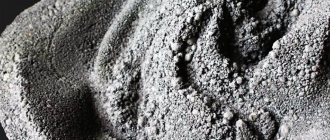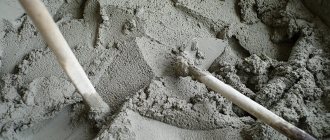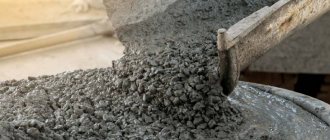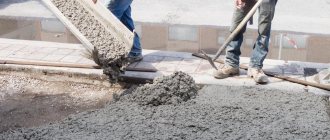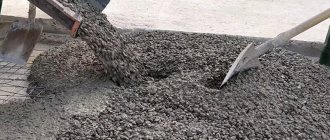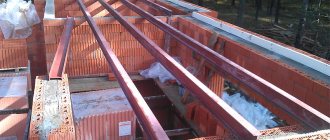When developing foundation projects, it is necessary to know the total weight of the structures and materials from which it will be built. Knowing the total weight load, you can accurately calculate the design of the foundation, determining its width and depth. Therefore, information about how much concrete weighs will be useful and even necessary not only for the designer, but also for every developer.
Separation of concrete by specific gravity.
The classification of concrete includes 4 groups with a weight range of 1 m3 of mixture:
1. Extra light – up to 500 kg.
They are also called cellular concrete; they do not contain large fillers. This solution consists of sand and concrete, and a foaming agent is added to it. Air pores form inside the solution (the volume of which is 85%). Lightweight concrete has a very low specific gravity: less than 500 kg. This group is most often used in the production of blocks and slabs, which serve as insulation materials in structures. Online calculation of the composition of cement mortar.
2. Light – 500-1800 kg.
For this type of concrete, various porous materials are used as fillers: foamed perlite, expanded clay, waste from various industries, vermiculite. The weight of concrete is reduced due to the porosity of the material, which is why it is called light.
The weight of 1 m3 of this species ranges from 500 to 1800 kg. Sand is not used in all types of lightweight concrete, but if it must be available according to the recipe, then its mass in 1 m 3 is about 600 kg. Lightweight concrete mortars are used when pouring fences, screeds, and block products.
3. Heavy - 1800-2500 kg.
This group of concrete solutions contains heavy and coarse fillers (coarse sand, gravel, crushed stone). The weight of 1 m 3 ranges from 1800 to 2500 kg. The recipe for heavy concrete shows that it is the fillers that occupy the bulk of the mixture.
The standard recipe consists of: crushed stone or gravel - 1200-1300 kg, sand - 600-700 kg, cement - 250-450 kg, water volume - 150-200 l.
This type of concrete is considered classic (traditional), they are widely used in various construction works, for example, pouring screeds, load-bearing structures, fences.
4. Particularly heavy – 2500-3000 kg.
This type of concrete is not used in the construction of private housing construction; most often they are used in nuclear reactors as a protective structure. The mass of 1 m 3 in such concrete ranges from 2500 to 3000 kg. The bulk of them is occupied by large aggregates.
What are the requirements?
Wall stones of this modification are made of heavy concrete, guaranteeing high strength characteristics. However, due to its weight, this type is not suitable for certain types of foundations, and in some cases they are produced hollow.
The decision to choose a specific type of foundation and wall stones is made by the design organization, taking into account:
Location of groundwater.- Soil characteristics in the building area.
- Stress values from the wall structure.
- Soil freezing level.
- Presence of a basement and utilities.
- Estimated service life of the structure.
The best foundation for concrete blocks is considered to be a strip foundation. The standard size is 40x20x20 cm, it is additional to the dimensions of the foundation, while they differ in design and weight:
- Solid (solid), p=2250 kg/m3, 36 kg;
- double-hollow, p=1530 kg/m3, 17 kg;
- three-hollow, p=1670 kg/m3, 20 kg;
- four-slit, p=1260 kg/m3, 20 kg;
- semi-slit, p=1450 kg/m3, 22 kg.
Calculation of the weight of concrete slabs
All construction companies face the need to find out the weight of a concrete slab or any other reinforced concrete product at one stage or another of construction. This question arises when it is necessary to transport concrete slabs, as well as directly during the construction of a building.
Concrete slabs with identical external parameters can differ significantly in their weight. The weight of the product is influenced by factors such as manufacturing technology, the composition of the concrete mixture, and what fillers were used by the manufacturer.
Features of the weight of concrete slabs
First of all, it should be noted that there are two values for the weight of a reinforced concrete slab - its specific and volumetric weight.
Specific gravity of a concrete slab. Speaking of specific gravity, ideally we mean a one-component material with 100% density, with a complete absence of pores. However, concrete products are created from several components, including various fillers, which give the slab structure and heterogeneity. Therefore, the calculation of the specific gravity in this case is made by adding together the specific gravity of the individual ingredients of the mixture, including the water that took part in the preparation of concrete.
Volumetric weight of the slab. Most often, it is the volumetric weight of the product that matters, since this indicator reflects the physical properties of the concrete slab. The importance of calculated data is difficult to overestimate. So, the lower the volumetric weight of a concrete slab, the less energy required for its installation, and the lower the cost of its transportation. At the same time, the indicator should not be less than the permissible minimum value so that the slab can perform the load-bearing functions assigned to it.
How to calculate the weight of concrete slabs
You can order concrete slabs from St. Petersburg from our company by choosing the type of product that suits the characteristics of your project.
Calculating the weight of a concrete product can be done in the simplest way, by weighing a sample, for example, one cubic meter. However, in the case of a finished concrete slab, this option is not relevant, so you can find out the weight based on data on the type of concrete and the filler used.
Why do you need to know how much a stone weighs?
There are several reasons why the developer will need to know the standard weight established by GOST and the actual weight of the blocks determined at the weighing complex when weighing the cargo:
- Checking the compliance of the production quality of the product by the difference in readings between the standard and actual weight;
- performing construction estimates;
- performing strength calculations of wall structures;
- calculation of the necessary transport and lifting equipment.
In the event that all calculations are carried out correctly and confirm the quality of the blocks used, then, based on the results of construction and installation work, the owners will receive a reliable and long-term foundation.
In order to protect yourself from counterfeits and low-quality products in spontaneous markets, it is better to purchase a large batch through a direct supplier from the factory with FBS quality certificates.
Instructions for using the calculator
This online calculator will help you calculate:
- area of the foundation base (for example, to determine the amount of waterproofing to cover the finished foundation)
- the volume of concrete required to pour the entire foundation with the given parameters. Since the volume of concrete ordered may differ slightly from the actual one, as well as due to compaction during pouring, it is necessary to order with a 10% reserve
- quantity of reinforcement, automatic calculation of its weight based on its length and diameter
- formwork area and quantity of lumber in cubic meters and in boards
- required amount of materials for preparing concrete - cement, sand, crushed stone
- as well as the estimated cost of all building materials
Step 1: First, set the dimensions of the foundation slab - its length, width and height. Next, fill in the parameters for calculating reinforcement and formwork. When calculating reinforcement, it is necessary to indicate the dimensions (length and width) of the cell that makes up one layer (row) of reinforcement, and the number of such rows (sections) in the reinforcement cage. As well as the diameter of the reinforcing bar. For formwork, indicate the dimensions of the prepared boards.
Step 2: When calculating concrete, keep in mind that the amount of cement required to make one cubic meter of concrete is different in each specific case. This depends on the brand of cement, the desired brand of concrete produced, the size and proportions of fillers. Default values for the proportions and quantities of cement, sand and crushed stone are given for reference, as usually recommended by cement manufacturers. You can change these values according to your requirements.
Step 3: When calculating the cost of building materials, please note that the cost of sand and crushed stone in the calculator is indicated per 1 ton. In suppliers' price lists, the price is most often announced per cubic meter. So you will have to recalculate the price per ton of sand and crushed stone yourself or check with sellers. In any case, the calculation will still help you find out the approximate costs of building materials for pouring the foundation.
When planning, do not forget about wire for tying reinforcement, nails or screws for formwork, delivery of building materials, costs for excavation and construction work.
Types and weight of wall blocks
Wall blocks are a modern material that is used for the construction of load-bearing walls and partitions in buildings for various purposes. They come in different shapes, sizes, and are made from concrete and additives and fillers.
Depending on the composition they are:
Note: large-size products include those 600x300x200 mm or more, all smaller ones are considered small-size.
Large-sized wall structures are used for the construction of load-bearing walls; their large mass requires the use of special equipment for transportation and installation.
Compared to brickwork, the use of blocks saves time, which means construction costs are reduced. They are easier to work with, they have good heat and sound insulation properties, and do not require cladding.
Expanded clay concrete blocks
They are made from expanded clay, water and cement. This material is porous, frost-resistant, with high sound and heat insulation, and fire-resistant. Expanded clay concrete is used for the construction of walls, partitions, foundations, chimneys, and fireplaces.
The strength and weight of expanded clay concrete depend on the ratio of the components. The volumetric weight of this material is 700–1200 kg/m3.
Note: expanded clay concrete blocks are divided into solid and hollow. The weight of hollow products is 4–17 kg, and monolithic ones up to 30 kg.
The weight of expanded clay concrete depends on several factors, the main ones being the density and grade of concrete. The higher the density, the greater the weight of the structure. Below is a table of the weight of blocks 200x200x400 mm by concrete grade.
Note: a large mass of expanded clay concrete product indicates non-compliance with production technology, excess moisture, or replacement of part of the expanded clay with crushed stone or slag. This affects the quality of the building material, its strength and thermal conductivity.
When purchasing expanded clay concrete, the deciding factor should not be price, but quality. It is important to purchase materials from trusted manufacturers and require certificates of conformity.
Foam concrete blocks
Foam concrete is produced from a mixture of cement with sand and a special whipped foaming agent. Both compositions are first prepared separately, then mixed into a single mass, poured into molds and dried under natural conditions.
Foam concrete is used for laying internal and external walls, constructing load-bearing elements in low-rise construction, roofs, ceilings, floors, and outbuildings as insulation.
Foam concrete structures are durable, have low thermal conductivity and high noise insulation, fire resistance and fire safety, and are easy to process.
Note: this building material is divided into grades based on density (D or D). For example, foam concrete D500 means that 1m3 contains 500 kg of solids, the rest is air.
By purpose they are:
Note: knowing the density of the product and its dimensions, you can calculate the mass using this table. For example, a foam block D600 is 0.2 * 0.3 * 0.6 m, then its volume is 0.2 * 0.3 * 0.6 = 0.036 m3, and its weight is 600 * 0.036 = 21.6 kg.
Foam concrete products of various weights, volumes, and sizes are used for construction. Depending on the brand of foam concrete, the weight of blocks of the same size will be different.
The versatility of use, ease of installation and cost-effectiveness make foam concrete a popular building material. When erecting buildings with your own hands, use the manufacturer’s instructions, which indicate the sequence of actions and the necessary auxiliary tools and materials. The relatively light weight of the blocks allows you to save on transportation and quickly complete the necessary work.
What determines the weight of a cubic meter of concrete?
No one will give a definite answer to this question without first asking several clarifying questions. The weight of concrete is a value that depends on a combination of indicators such as:
- brand of cement;
- type of aggregates;
- the amount of water used for mixing.
Depending on the above factors, the following types of concrete , differing from each other in their specific gravity, that is, the mass of a cubic meter:
Extra light
Most often these are cement mortars filled with small air bubbles or pieces of perlite, vermiculite and other light minerals. They are used as heat insulators, when sealing various seams, joints, and to eliminate cracks. They are not suitable for the manufacture of load-bearing structures. In this case, the weight of a cube of concrete does not exceed 500 kg.
Lightweight, grade M 100 or 150
The fillers in them are porous materials , for example, tuff, expanded clay or shell rock.
There are types of mortars that do not contain either heavy or light stones. Their low weight is explained by the presence of pores in the cement mortar itself. These include foam and aerated concrete. A cubic meter of such mixtures can have a mass from 500 to 1800 kilograms . A significant proportion of them is occupied by sand, which can be up to 600 kg in a cube of the finished solution. Such concrete mixtures are used to make wall blocks.
Heavy, grades M 200, 250, 300
gravel or crushed stone act as fillers . They are prepared using the proportion 1:2:4:0.5 or 1:3:5:0.5, where the first number is the volumetric content of the binder component - cement, and the rest are sand, crushed stone and water, respectively.
For example, to prepare a cubic meter of such concrete mortar it will be necessary to spend from 250 to 400 kg of cement, depending on its brand, 600 - 700 kg of sand, 1200 - 1300 kg of gravel or crushed stone and fill this mixture with 170 - 200 liters of water.
Consequences of incorrect parameter definition
If you purchased FBS stones that are lighter than required by GOST, then in this case there were gross violations in the production process; in fact, this is a defect and it will be difficult to predict how it will behave as a foundation.
It is better not to buy such blocks, especially for multi-storey buildings.
Determining the dimensions of the foundation and its weight forms the basis for calculating the load that it is capable of carrying during operation. Taking it as a basis, the loads of the weight of the structure, snow and wind influence and additional operating pressure are determined.
If the load-bearing properties of a foundation made of “lightweight” FBS are weakened, then naturally it will not be able to support all of the above loads - the structure will collapse.
For high-rise buildings, at the design stage, not only the brand of concrete blocks is indicated, but also their manufacturer. In addition, during the construction process, the developer must organize high-quality technical control over the compliance of purchased building materials with certificates, design and GOST requirements.
How to calculate the mass of a cubic meter of concrete
All the above parameters are regulated by SNiP standards No. II-3 , established back in 1979. This document also provides more precise values for concrete using specific aggregates (all values in kg/cubic meter):
- reinforced concrete structures - 2500;
- crushed stone, gravel - 2400;
- tuff - from 1200 to 1600;
- pumice and other fractions of volcanic origin - from 800 to 1600;
- expanded clay - from 500 to 1800;
- foam and aerated concrete - from 300 to 1000.
You can also determine the mass of a cubic meter of ready-made concrete based on its brand. The specific gravity of concrete in kg/cubic meter is given below:
Table “Specific gravity of concrete (1m3) of various grades”
If you need data specifically for your concrete, and not average indicators, you can make the calculations yourself. To do this, you need to know the content and brand of each component of the mixture.
What is bulk density and where to get it
The weight of 1 m3 of a substance without voids is called its true density.
There you can find the characteristics:
The unit of measurement is the same for everyone - it is t/m3 or kg/m3. Of course, going into subtleties and relativity, they are not equal to each other. But, if we are not talking about construction in space, then to find out how much 1 m3 of concrete weighs, you can use any of these values.
Especially for rough calculations on a construction site, or large-scale collection of weight for estimates or cargo transportation.
Note: if a dimensionless value is indicated, for example, as in the passport for reinforced concrete products, then you need to look at the number of characters. That is, if it is a 3 or 4-digit number (500, or 2400 as in the picture above), the unit of measurement will be kg/m3. If the value is small and fractional (0.5 or 2.4), it is indicated in t/m3.


